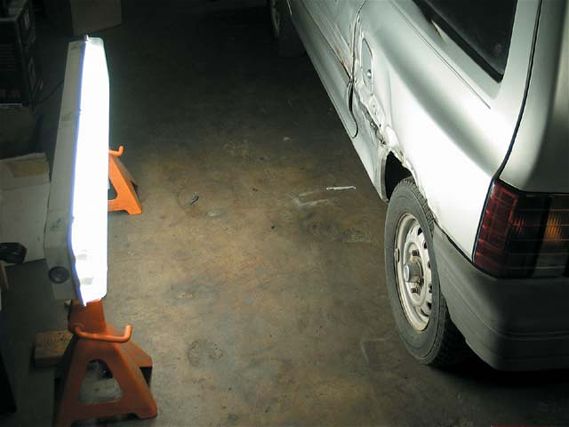 | The Overkill Drop Light can be placed on jack stands to illuminate the side of a car evenly and energy efficiently.
| The Overkill Drop Light can be placed on jack stands to illuminate the side of a car evenly and energy efficiently.
It takes a better writer than me to put romance into having coolant running down your arm at 1:00 a.m. on a Saturday, with the knowledge that several of your friends have already gathered in Las Vegas and are doubtless enjoying themselves while introducing other, slightly less poisonous organic compounds into their bodies. That writer's name is Peter Egan, and I can probably blame the foregoing experience on reading too much of his Road & Track column, "Side Glances," during my adolescence. His April, 1996 column was titled "The Right Tool for the Job," and contained the following description:
Trouble light: The mechanic's own tanning booth. Sometimes called a drop light, it is a good source of vitamin D, "the sunshine vitamin," which is not otherwise found under cars at night. Health benefits aside, its main purpose is to consume 40-watt light bulbs at about the same rate 105mm howitzer shells might be used during, say, the first few hours of the Battle of the Bulge. More often dark than light, its name is somewhat misleading.
Dave Coleman, of sister publication Sport Compact Car, figured out that bulb life was usefully improved if heavy-service bulbs were used. Still, there was room for improvement. Enter Dr. Overkill.
I stole this from the guys at Barry White's Street Rod Repair Company, who work on high-end custom-built cars six days a week and use wet-environment fluorescent light fixtures as drop lights. The fixtures are meant to be installed by contractors, so you'll need some extras: two light tubes, a grounded power cord of sufficient gauge and an adapter to strain relieve and seal the cord where it exits the housing. I bought the fixture at Home Depot and found a suitable cord in my box of electrical junk, likely salvaged from an obsolete Hewlett-Packard Apollo 1100 work station after some freshmen threw it off the third floor of my college dorm. Casters enabling the light to be pushed around under the car are a useful addition I have yet to make.
A conventional trouble light is so small and underpowered that it needs to be continually moved from point to point as work moves around under a car. The cord can get in the way, and if it uses an incandescent light source, it is one more way to burn oneself. Simply placing the overkill fixture under the edge of a car when it is up on jack stands provides enough illumination to work on almost any part, even in an otherwise dimly lit shop. Because the light is emitted from a large area, shadows are eliminated or reduced, which also makes photography easier.
When you pull the block drain plug and your 325is project starts raining blue BMW coolant over a square meter, you at least don't have to worry about electrocution. The light is sealed against most automotive liquids and is easily cleaned. It is big enough that its top surface can be used to organize small tools and fasteners without hindering light output; the parts are off the ground so a creeper won't roll over them, and they can be easily located and identified.
Nobody markets the overkill drop light for automotive use, but it's a great idea. I've used it on a couple of projects now, and it's been a tremendous improvement.
